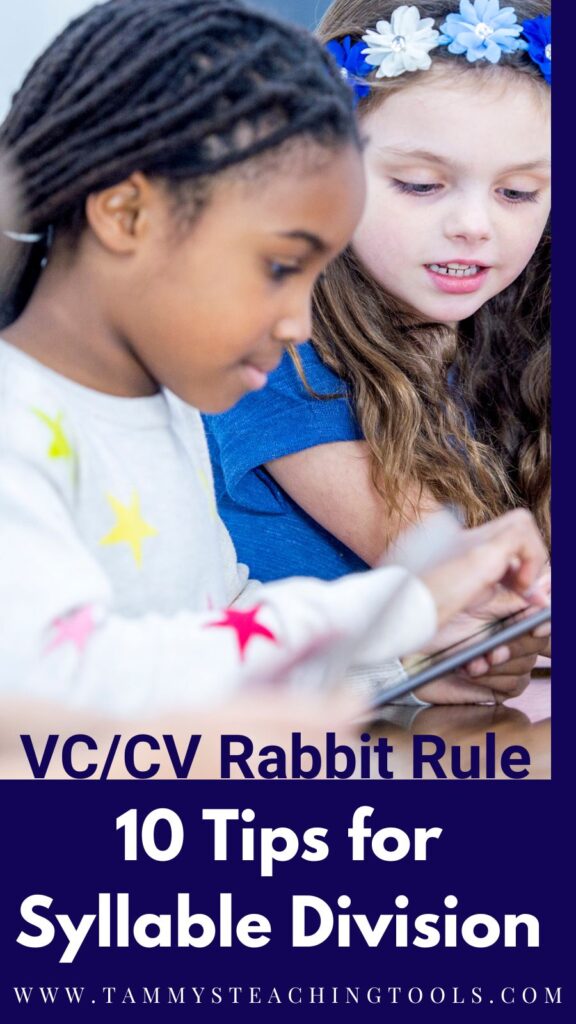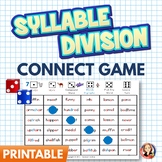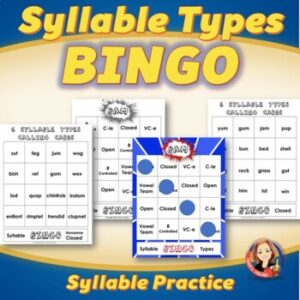10 Tips for Teaching Syllable Division Between Consonants
Teaching syllable division between consonants can be tricky for kids. They must understand the VC/CV syllable division rule to divide words correctly. Multisyllable words don’t have to be scary. In this blog post, I will provide 10 tips that help make teaching and learning this concept a bit easier!
Why Teach the VC/CV Syllable Division Rule?
Knowledge of syllable types and syllable division rules is an essential skill for reading accurately and fluently. It provides a strategy for breaking words into manageable parts and correctly decoding them.
When readers can recognize syllable types, they have a way to determine if a vowel has a long, short, diphthong, r-controlled, or consonant-le sound. They can also draw on this knowledge to find correct spellings.
It is crucial that students can distinguish the sound of a syllable within a word and be able to manipulate that sound.
Tips for Teaching Syllable Division
1 Start with the basics.
Before diving into syllable division, make sure your students understand the concept of a syllable. You can do this by having them clap their hands or stomp their feet to count the number of syllables in different words.
► What is a Syllable? A syllable is a word or part of a word with one vowel sound.
► Explain that words are made up of syllables. Some words have one syllable. Some words have many syllables.
► Consonants and vowels work together to make a syllable. Syllables make words.
► Syllables may be words or parts of words. Make sure to provide examples.
► One way to tell how many syllables are in a word is to place your hand under your chin and feel the number of times your jaw drops for a vowel sound.
 ► A fun activity is to have students count and clap the number of syllables in their names, their classmates, and their family’s names. Make it active by having students group themselves by the number of syllables in their name. You can also replace clapping with other actions.
► A fun activity is to have students count and clap the number of syllables in their names, their classmates, and their family’s names. Make it active by having students group themselves by the number of syllables in their name. You can also replace clapping with other actions.
2. Use word lists
Create a list of words that follow the VC/CV rule and another list of words that do not follow the rule. This will help your students see the pattern and better understand how to divide words correctly.
10 words that follow the VC/CV syllable division rule:
rabbit hiccup
hidden possum
blanket mitten
publish tennis
traffic happen
► Start with words that have the same middle consonants, like rab/bit.
► Add words with two different middle consonants, like tur/nip. Also, use compound words, like cat/fish.
3. Mark the Vowels and Consonants
► Have students identify the vowels in the word and mark them with the letter v.
► Find the consonants and mark them with the letter c.
► Divide the word between the two consonants.
► Draw a curved line under each syllable.
► Students should read each syllable out loud, then read the entire word.

4. Get creative with games
Games are a great way to help kids learn new concepts. Try using flashcards or playing charades to review VC/CV words. Syllable Connect is a fun student favorite. You can make your own on a grid or get 13 different premade games below. Syllable bingo is another favorite.
5. Incorporate movement
Movement can help kids better understand and remember new information. When introducing syllable division, have your students stand up and clap or snap their fingers for each syllable in a word.
6. Use visual aids
Visual aids are always helpful when teaching new concepts. Use pictures or diagrams to help your students see how words are divided into syllables.
7. Practice, practice, practice!
The more exposure your students have to the concept, the better they will understand it. Try having them divide words aloud or write words out on paper, dividing them into syllables as they go.
8. Make it fun!
Learning doesn’t have to be boring. Add fun and excitement to your lesson by incorporating music, acting, or other creative activities.
9. Reward progress
When your students are doing well, be sure to give them positive reinforcement. This will help them stay motivated and encourage them to keep up the good work.
10. Be patient
Teaching kids can be challenging, but it’s important to remember that they’re just kids! They’ll get there eventually – be patient and keep at it!

For more information on teaching syllable types, see this post: Teaching the Six Syllable Types.
♥ For more help, see over 60 resources at Tammy’s Toolbox designed to teach syllable division and syllable types.









